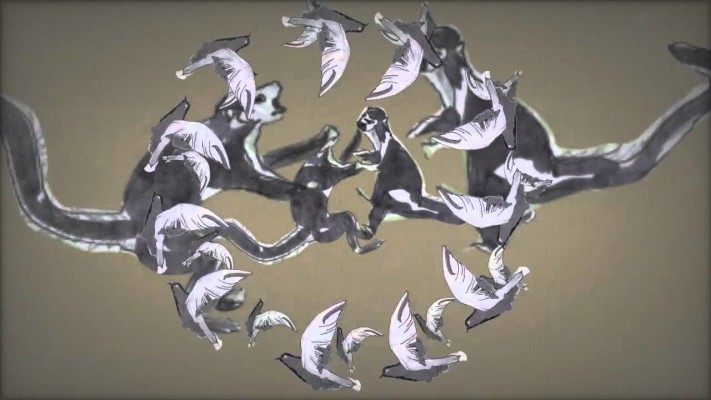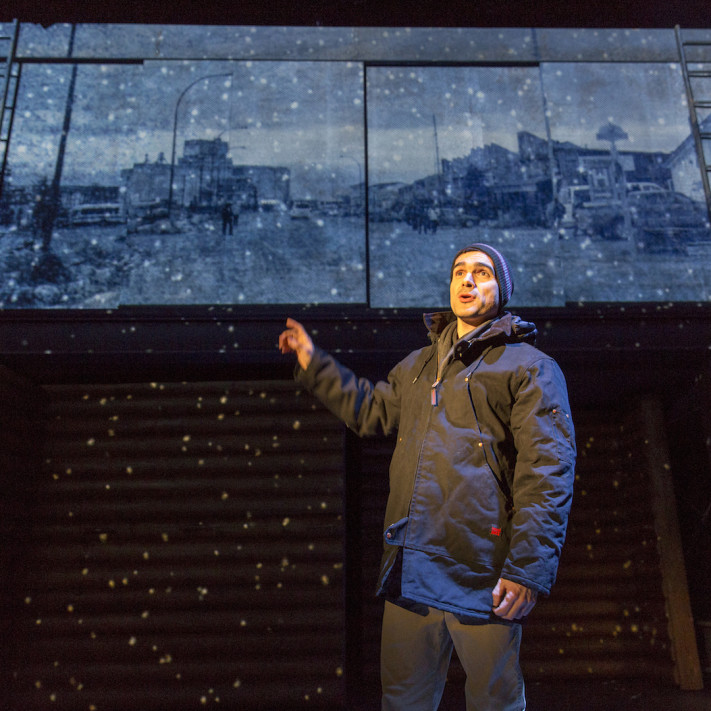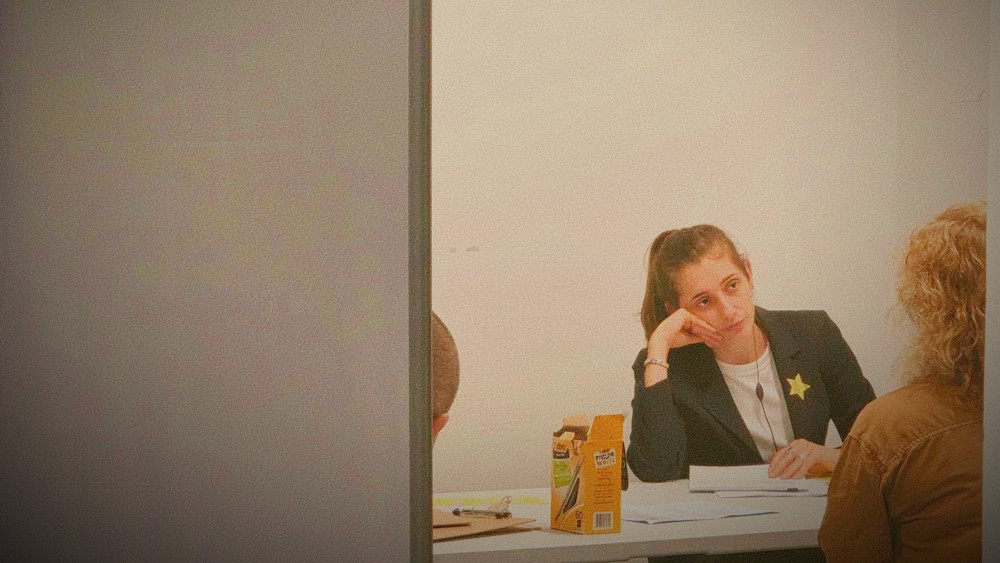In 2014, The Civilians presented The Great Immensity, the first major American play about climate change, at the Public Theater. Written and directed by the Civilians’ Artistic Director Steve Cosson, with music and lyrics by Michael Friedman, The Great Immensity is an eclectic thriller, diving into the challenges of climate change against the backdrop of the Paris Climate Accords.
One of the standout songs from The Great Immensity is “Martha, the Last Pigeon/The Golden Lemur,” a wry and compassionate song about isolated members of endangered species.
The interdisciplinary artist Alix Lambert illustrated and directed a music video for “Martha” back in 2014, animated by Brian Young and accompanied by a recording of the song performed by Michael Friedman. Now, their video is being re-released with a new recording of “Martha,” performed by the original New York cast for a world premiere cast album, made possible by the Michael Friedman Legacy Fund.
I spoke to Alix and Brian about the process of making the “Martha” music video and what Michael’s work means to them.
Alix Lambert
DANIEL KRANE: What does “Martha” mean to you? As an artist, what excites you about that song?
ALIX LAMBERT: I love stories that tell a bigger story through one small place. Mass extinction, that was kind of all told through Martha’s story. I do that a lot in my work, where I’m looking at prisons in Russia and it tells the whole story about Russia during that year. In this case, I love the song, and in terms of the subject matter, something broad like extinction gets narrowed down and told through this one pigeon.
DANIEL: One very special pigeon.
ALIX: A very special pigeon. And some lemurs. Don’t want to leave the lemurs out.
DANIEL: Did you have any sources of inspiration when you were drawing the art for Martha?
ALIX: I just Googled pigeons. I looked at Martha herself, like the actual Martha, and I looked at other pigeons and I cast for more.
DANIEL: What’s the process of going from drawings to an animated music video?
ALIX: I went to Brian with all of these drawings and there were things that I wanted. I really wanted a Busby Berkeley kind of thing, that whole thing where they go in circles. Mostly, it would be like, “Can you do this?” and then he would do all the heavy lifting.

DANIEL: Is that what directing a music video looks like? Is it, “I have this picture of how I think this song can be. Brian, can you help with that?”
ALIX: Yes. At least for me, it’s a lot of not having any skills myself, but knowing how to tell other people what I think could work well. And that’s been great! I mean, I’m kind of joking but I also think you have a vision for what it is, and how that gets realized is going to be dependent on your collaborative team.
DANIEL: You’ve done other animated videos with your projects before. What kinds of storytelling possibilities do you think animation offers?
ALIX: For one thing, I think it reaches a different audience, which I appreciate because the subject matter I work with is pretty dark, depressing, and miserable. Not everyone wants to go to a feature film about the worst, most horrible things. I’m interested in criminal justice reform and I did two different animated shorts: one was 2-D animation, based on interviews in my crime book. The other one is claymation 3-D stop-motion animation about animals in prison. That one’s called “Prison Zoo” and a different audience will engage with it and maybe, hopefully, think about criminal justice reform that’s not going to engage with it otherwise.
DANIEL: The Michael Friedman Legacy Fund is working to preserve the work that Michael did with the Civilians and artists like you over the years. What does it means to you that that fund exists and that his work is being recorded?
ALIX: We all miss Michael. It’s still, I think heartbreaking. It always will be, but it’s still pretty new, and, you know, I miss him. I love him very much. I think he was really brilliant, and I just feel glad I had the opportunity to make something with him. I met him right when he was out of school; I remember Steve introducing me to him. I don’t know what to say except for what has frequently been said which is, “He was a genius and his work should be archived and made available. And I just feel happy to be involved in it.” Obviously, it’s sad to have this reason for it. Did you meet Michael ever?
DANIEL: I met Michael twice. I almost directed Mr. Burns [a play by Anne Washburn featuring Michael’s music] in college.
ALIX: Oh really?
DANIEL: He was teaching at Princeton right before he passed. I was just beginning to fall in love with theater and all of a sudden I was getting coffee with this bigwig musical theater composer. He was immediately extremely generous in sharing about his work, chatting a mile a minute. I probably said two questions in the whole time we were together but it meant a lot to me that he was willing to open up to a total stranger.
ALIX: Yeah, we had a good time. Michael always said the best piece of theater we ever saw was at three in the morning at a McDonald’s in Brooklyn trying to find food. We finally find this McDonald’s and we see these like kids in front of us. Only the drive-in window is open and they don’t have a car. They’re standing and they’re trying to order, and they’re like, “You can’t walk up to the drive-in window, you can’t buy something there.” And it was insane. So they went around, they were still in front of us, and it was four of them, in a fake car: they pantomimed the whole thing and went back up to the window, like adjusting their mirrors. It was really good, we used to talk about it like all the time, like, “This is really good theater, this is the best thing we’ve seen!” And they gave them their food.
DANIEL: That’s amazing.
ALIX: They got their McDonald’s for the effort. And their A-plus performance.
DANIEL: Well good, now they’re memorialized.
ALIX: Yeah, Michael has blurbed it for years, unbeknownst to them.
Brian Young
DANIEL: Could you say a bit about what “Martha” means to you? What sorts of things you were thinking about when you were working on the video?
BRIAN YOUNG: Well, it’s a lot of fun. The lyrics are very visual and so we were just trying to illustrate what was going on in the song and the various scenes in that. We tried to find a way to make it interesting. Martha is yearning for companionship, and she’s all alone, and the idea was, “How is she not alone?” She imagines this Busby Berkeley self-existence, you know, herself repeated over and over and over again. That’s where the animation concepts came from, but really we were just illustrating the visual poetry of the song.
DANIEL: You’re an animator. What kinds of storytelling capabilities do you think animation has to bring the story of “Martha” to life? What makes it a useful tool for opening up Martha or this lemur?
BRIAN: It’s nice because you can kind of do anything: it’s your imagination. You can be as fun or as serious and sad as you want to be. In film, even though there’s visual effects, you’re often tied to something that looks real, whereas in animation, you don’t have to rely on the practicality of the real world. You can just have fun with it and do whatever. It doesn’t matter if two things that would normally not be in the frame together are together. You can play with graphic design and be more illustrative than you can in other mediums.
DANIEL: Which is especially fun in a song like “Martha” which is both about a really depressing subject, extinction, and is also droll and funny at the same time.
BRIAN: It’s really such a fun song, but it’s so tragic if you think about what it’s actually about. So we’re just trying to have fun but also drive home the sadness of the story. I think Michael, the way he wrote it, it’s both tragic and fun at the same time.
DANIEL: I confess, I have almost no knowledge of how animation works. Could you talk me through what the process was of going from Alix’s drawings and your conversations to the video that you guys made, and what that work actually looks like?
BRIAN: Alix drew some stills of things to match to what was going on in the song, and it was storyboarded out, meaning timed to the song. We figured out where we had holes and where we needed something else. Like, at some point we needed someone pointing at a blackboard, and so Alix would fill that in and then, once we had the still versions of everything placed into a timeline, we would figure out how to transition between the still images and then come up with interesting and fun ways to move things around and flow from one scene to the next. The beginning versions of these things always look really, really boring and still, and it’s like, “Okay, we definitely need to fill in the gaps with something.” Then, you end up working on it until it feels full.
DANIEL: What kinds of software or technology did you use to bring it to life? Did Alix do the drawings digitally or by hand?
BRIAN: They’re actually really beautiful, the originals. She did them on this semi-transparent sort of transparency. I can’t remember if I scanned them or if I photographed them— it was a while ago. I probably photographed them and then brought them into Photoshop, cleaned them up a little bit, and then did all the animations in a program called Aftereffects. They’re both Adobe programs.

DANIEL: “Martha” comes from a musical, and this music video exists apart from a stage production or even apart from the cast album; it exists as its own interpretation of the song. How do you think the video works in conjunction with the musical? What does the music video add or do differently?
BRIAN: I think it’s just a little sidecar. At the time the show was going on, each character in the show had a blog up on thegreatimmensity.org. It was really fun, it was like each character’s storytelling life of their own. I feel like this is just like a spinoff of the show. You know, not necessarily directly related—more like an abstract sidecar to it.
DANIEL: As a person who both collaborated with Michael Friedman and is a member of his family [Brian is Michael’s brother-in-law], what does the Legacy Fund mean to you?
BRIAN: I think it’s amazing that it’s happening. I saw a lot of his shows, but I didn’t see them all, so now I get to hear shows that I didn’t get to see, which is great. I think the most important thing is that everybody is going to be able to hear his work in the future. Since there won’t be any new material, it’s just good to preserve it. It means a lot to a lot of people.
DANIEL: That’s actually one of the things I love about the “Martha” video you made. It’s exciting to hear the new cast recording and get a picture of what the production was like, and it’s also special to hear Michael singing the song on the original video you guys made together.
BRIAN: Yeah, I love that version so much. Because usually his work was sung by other people, that was a really cool opportunity to preserve him working through a song. It’s obviously even more powerful now that he’s not here anymore.
DANIEL: Is there anything else you want to add?
BRIAN: Getting to watch it again, I realized it was a unique opportunity to work on something like that, because with animation, you’re usually selling something commercial, whereas this was a passion project. It was just fun.
Authors
-
Daniel Krane is a Brooklyn-based director, playwright, and arts journalist. He was the Civilians' Editorial and Social Media Intern for the 2019-2020 season. In addition to his work at the Civilians, he served as the Artistic Director at Princeton Summer Theater for two critically-acclaimed seasons, and has worked for the Public Theater's Public Works program and the Brooklyn Arts Exchange. His writing has been featured in American Theatre Magazine, Exeunt NYC, and Extended Play. He received his B.A. from Princeton University in 2018, where he studied Portuguese and Theater. DanielKrane.com
View all posts -

Alex Lambert has directed and produced three feature-length documentaries: The Mark of Cain, Bayou Blue, and Mentor, as well as numerous shorts. She was a writer on the HBO show Deadwood and a writer/producer on John from Cincinnati. She has conceived, written, and directed two short series for MOCA tv: Crime: The Animated Series, and Ambiance. She is the author of Crime and The Silencing. Patreon: www.patreon.com/user?u=22964805.
View all posts -
Brian Young is an editor, animator and visual effects artist living in New Jersey near some woods. He frequently ventures to New York City to collaborate on narrative and documentary film projects.
View all posts









